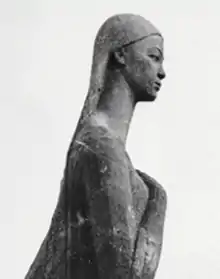Nurkhon Yuldashkhojayeva
Nurkhon Yuldashkhojayeva (Uzbek: Nurxon Yoʻldoshxoʻjayeva, often anglicized as Nurkhon Yuldasheva) was one of the first Uzbek women to dance onstage without a paranja veil.[1] She was born in 1913 in Margilan, a city in Fergana Province and was murdered in an honor killing in 1929.[2]
Nurkhon Yuldashkhojayeva | |
|---|---|
Nurxon Yoʻldoshxoʻjayeva Нурхон Йўлдошхўжаева | |
 | |
| Born | 1913 Margilan, Russian Turkestan (present-day Uzbekistan) |
| Died | July 1, 1929 (aged 16) Margilan, Uzbek SSR, USSR |
| Cause of death | Stabbed in an honor killing |
| Monuments | Statue dedicated in 1960s but removed shortly after Uzbekistan gained independence |
| Occupation | Dancer, actress |
| Known for | Removing veil in public |
Honor killing
Nurkhon ran away from home at a young age to join a Russian dance troupe.[3] Her colleagues there included the future People's Artist of the USSR Tamara Khanum and the future People’s Artist of Uzbekistan Gavkhar Rakhimova. Shortly after joining the group, on 8 March 1928 she and another dancer went onstage and publicly removed their face-veils. When the dance troupe was visiting her hometown of Margilan she decided to visit her family. Her aunt brought her into the house, and told her that her brother was looking for her. He then stabbed her to death, and immediately confessed to the crime after police arrived at the scene.[4] He had admitted that the murder was premeditated, at the insistence of their father, the ming-boshi and mullah Kamal G'iasov, who made him swear on the Koran to kill her.[5] The day after her death a massive funeral was held in the public square. Thousands of people attended the memorial, and women threw off their face-veils in front of her coffin.[4][6] Her father and brother were eventually tried and executed for their role in the murder, and the ming-boshi and mullah were exiled.[5]
Aftermath
After her death she was honored by the authorities of the USSR as a courageous Soviet role model and martyr, similar to that of Tursunoy Saidazimova. A statue of Nurkhon[7] was built and placed in Margilan in front of the House of Culture. Made by sculptor Valentin Klebanov in 1967,[8] Nurkhon's statue was taken down in 1993 shortly after the disestablishment of the Uzbek Soviet Socialist Republic in 1991;[9][10] A monument to a young woman representing the struggle for feminine emancipation was considered immoral in post-Soviet Uzbekistan.[11] In the city of Ferghana there is a cinema that still bears her name though, the "Nurkhon" cinema.[12]
Nurkhon became the heroine of a Soviet musical play by Kamil Yashin popular throughout the mid 20th century.[13]
References
- Vitkovich, Victor (1954). A Tour Of Soviet Uzbekistan. Moscow: Foreign Languages Publishing House. p. 98.
- National Encyclopedia of Uzbekistan (OʻzME). Birinchi jild. Tashkent, 2000 link
- Rubin, Don (1999-04-30). World Encyclopedia of Contemporary Theatre. p. 458. ISBN 9780415260879. Retrieved 2010-09-12.
- "Женщина и свобода в выборе одежды". Anhor.uz (in Russian). 16 January 2017. Retrieved 2019-01-29.
- Kamp, Marianne (2011-10-01). The New Woman in Uzbekistan: Islam, Modernity, and Unveiling under Communism. University of Washington Press. p. 206. ISBN 9780295802473.
- Avdeeva, Lyubov (2009). Тамара Ханум. Моя жизнь. Воспоминания о себе и выдающихся деятелях искусств Узбекистана. Tashkent: Национальной библиотеки Узбекистана имени А. Навои.
- Picture of the statue - Boy Looks up at Statue of Nurkhon
- "Sculptors". O'zbekiston haykaltaroshligi.
- Colin Thubron, The Lost Heart of Asia. Heinemann, 1994
- The Moscow Times, Volume 2, Issues 46-57. Moscow Times. 1995. p. 36.
- MacLeod, Calum; Mayhew, Bradley (2004). Ouzbékistan: Samarcande, Boukhara, Khiva (in French). Olizane. p. 141. ISBN 978-2-88086-313-5.
- ""Days of the Uzbek National Cinema Arts" held in Margilan". Uzdaily.com. Retrieved 2010-09-12.
- "Great Soviet Encyclopedia {ru}". Bse.sci-lib.com. 2007-07-08. Retrieved 2010-09-12.